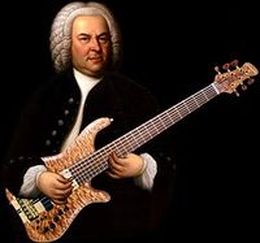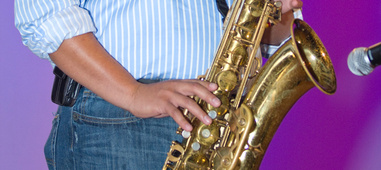Improvisation in music is probably one of the most mystifying of the many skills which can be developed by a pro musician. People who can do it at a high level make it look effortless, leaving all the square cats not in-the-know exclaiming, “They did that without reading music, and they made it up as they went…and it was good? IMPOSSIBRU!” Likewise, many musicians (especially those who begin with a regimented course of study) are reduced to being no better than blundering fourth graders when asked to improvise a passage of music, briefly mumbling that they don’t know how to improvise before sitting down and churning out some Paganini.
However, this hesitation is unnecessary. Improvisation in music is only scary so long as one subconsciously holds on to the belief that there is a single, “right” way to learn anything. Improvisation is as limitless and varied as the people who pursue it as a serious course of study are. Music, as an artistic discipline, is supposed to be creative. What is more creative than making music on the spot in real time? At least for me, improvisation is the height of what a musician can be – completely honest, a fully-grown and developed version of themselves both technically and spiritually as expressed through music.
While those of us who have gone through formal academic music training might be encouraged to think that there is a “correct” way to learn to improvise, I believe that there are many routes a musician can take to develop this skill, and figuring out what combination of methods will work at any given time for the individual is a part of an endless journey of self-enlightenment. Over the next few blog posts, I will be talking about a few of these methods, the advantages and disadvantages of both, and providing some resources that someone can use as a starting point if they’re interested in pursuing any of this.
In these entries, I will be referring to improvisation in a jazz context, but I have used many of these concepts while playing in other styles, and I have used things I have learned studying other styles in jazz. All things in music are connected. If you can’t accept that concept, you probably have no business improvising.
#1 – Licks and Such Tricks
In these entries, I will be referring to improvisation in a jazz context, but I have used many of these concepts while playing in other styles, and I have used things I have learned studying other styles in jazz. All things in music are connected. If you can’t accept that concept, you probably have no business improvising.
#1 – Licks and Such Tricks
What It Is: Constructing musical phrases from a series of pre-learned licks, sort of like interchangeable parts on a machine.
Pros: easily quantifiable, a huge number of resources available for learning new licks, increasing theory knowledge can increase the mileage a single lick gets significantly
Cons: can remove all of the creativity from the music being performed, can make the musician overly predictable and numb to musical interaction between themselves and the other members of the group
Perhaps one of the easiest ways for any musician to begin improvising would be a licks-based approach. This is especially good for musicians who were trained classically before attempting to study improvisation. There are no vague terms, no gray areas about when certain notes work and when they don’t, and no mystical mediation on a mountain to find yourself. Just memorizing and shredding licks in all keys.
Pros: easily quantifiable, a huge number of resources available for learning new licks, increasing theory knowledge can increase the mileage a single lick gets significantly
Cons: can remove all of the creativity from the music being performed, can make the musician overly predictable and numb to musical interaction between themselves and the other members of the group
Perhaps one of the easiest ways for any musician to begin improvising would be a licks-based approach. This is especially good for musicians who were trained classically before attempting to study improvisation. There are no vague terms, no gray areas about when certain notes work and when they don’t, and no mystical mediation on a mountain to find yourself. Just memorizing and shredding licks in all keys.
One of the greatest advantages of this method is that it takes some of the vagueness out of improvising. You learn this lick, it works over a ii-V-I progression, and hey, I learned some more theory, and it turns out this lick also works over this, this, and this. Awesome! Pre-learning licks and being able to chain them together is also the best way to prep for those breakneck-speed tunes where thinking about what you’re playing is near-impossible. If you train yourself to play certain things fast, it’ll come out when you need to play fast instead of the musical barf you’re doing right now.
On the other hand, pre-learning every single thing you’re going to play when “improvising” isn’t really improvising. This is actually one of the major issues I have with many modern jazz musicians: most of them sound exactly the same. Everyone studied the same licks. Everyone learned the same tunes. Everyone transcribes Michael Brecker. Everyone sounds the same. Can music really pride itself as a “creative” subject if no one is actually doing anything new or different?
If interested in taking a licks-based approach, it requires a basic knowledge of your major and minor scales, as well as the “basic” scale that connects to each of the commonly-used chords (major, minor, dominant, half-diminished, and diminished). These are things you should probably learn for any method of improvising, but not knowing these things will make a licks-based approach much more difficult aside from a few easy tunes in only a few common keys.
Licks can be pulled from recordings you like (of any genre), any books with written music in it, and even any musician friends you have who play the same three things over and over.
If interested in taking a licks-based approach, it requires a basic knowledge of your major and minor scales, as well as the “basic” scale that connects to each of the commonly-used chords (major, minor, dominant, half-diminished, and diminished). These are things you should probably learn for any method of improvising, but not knowing these things will make a licks-based approach much more difficult aside from a few easy tunes in only a few common keys.
Licks can be pulled from recordings you like (of any genre), any books with written music in it, and even any musician friends you have who play the same three things over and over.
Resources to Check Out:
1.) “Hip Licks for Saxophone” by Greg Fishman
2.) Transcription Books Like This
3.) YouTube Videos Like This
1.) “Hip Licks for Saxophone” by Greg Fishman
2.) Transcription Books Like This
3.) YouTube Videos Like This
Image Credit Links:
Monk: http://www.labgrab.com/files/science-news/images/LabGrab/Buddhist_Monk.jpg?1310158811
Sax Meditation: http://pad2.whstatic.com/images/thumb/3/3a/Meditation-1.jpg/251px-Meditation-1.jpg
Bach Shreds: http://www.wnyc.org/i/200/0/c/80/1/bach_bass.jpg
Waterfall: http://misslisee.files.wordpress.com/2013/04/p1000997.jpg
Sax Pic: http://advocacy.collegeboard.org/sites/default/files/images/preparation-access/undocumented-students-and-dream-act/sam-profile-undocumented-sax-player/sam.jpg?1363038361
Cantina Band: http://i1.ytimg.com/vi/hmv5xyMyt_w/hqdefault.jpg
Monk: http://www.labgrab.com/files/science-news/images/LabGrab/Buddhist_Monk.jpg?1310158811
Sax Meditation: http://pad2.whstatic.com/images/thumb/3/3a/Meditation-1.jpg/251px-Meditation-1.jpg
Bach Shreds: http://www.wnyc.org/i/200/0/c/80/1/bach_bass.jpg
Waterfall: http://misslisee.files.wordpress.com/2013/04/p1000997.jpg
Sax Pic: http://advocacy.collegeboard.org/sites/default/files/images/preparation-access/undocumented-students-and-dream-act/sam-profile-undocumented-sax-player/sam.jpg?1363038361
Cantina Band: http://i1.ytimg.com/vi/hmv5xyMyt_w/hqdefault.jpg






 RSS Feed
RSS Feed